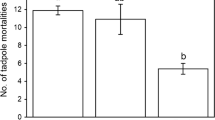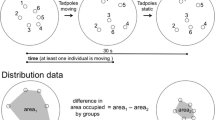Summary
Tadpoles of the barking tree frog, Hyla gratiosa, are abundant in spring and summer in some ponds and Carolina bays on the Savannah River Plant near Aiken, South Carolina. To determine how these tadpoles survive in the presence of predaceous salamander larvae, Ambystoma talpoideum, and larvae of an aeshnid dragonfly, Anax junius, we determined fields densities and sizes of the predators and the prey and conducted predation experiments in the laboratory. Tadpoles rapidly grow to a size not captured by Ambystoma, although Anax larvae can capture slightly larger tadpoles. Differing habitat preferences among the tadpoles and the two predator species probably aid in reducing predation pressure. Preliminary work indicates that the tadpoles may have an immobility response to an attack by a predator. In addition, the smallest, most vulnerable tadpoles have a distinctive color pattern which may function to disrupt the body outline and make them indiscernable to predators.
Similar content being viewed by others
References
Altig R (1970) A key to the tadpoles of the continental United States and Canada. Herpetologica:26:180–207
Altig R (1972) Notes on the larvae and premetamorphic tadpoles of four Hyla and three Rana with notes on tadpole color patterns. J Elisha Mitchell Sci Soc 88:113–119
Anderson JD, Williamson GK (1974) Nocturnal statification in larvac of the mole salamander, Ambystoma talpoideum. Herpetologica 30:28–29
Barr AJ, Goodnight JH, Sall JP (1976) SAS User's Guide, SAS Institute Inc Raleigh NC p 494
Brodie ED, Jr, Johnson JA, Dodd, KC, Jr (1974) Immobility as a defensive behavior in salamanders. Herpetologica 30:79–85
Calef GW (1973) Natural mortality of tadpoles in a population of Rana aurora. Ecology 54:741–758
Calvert PP (1934) The rates of growth, larval development and seasonal distribution of dragonflies of the genus Anax (Odonata: Aeshnidae). Proc Amer Phil Soc 73:1–70
Dodd KC, Jr, Brodie ED, Jr (1976) Defensive mechanisms of Neotropical salamanders with an experimental analysis of immobility and the effect of temperature on immobility. Herpetologica 32:269–290
Heyer RW, McDiarmid RW, Weigmann DL (1975) Tadpoles, predation and pond habitats in the tropics. Biotropica 7:100–111
Heyer RW, Muedeking MH (1976) Notes on tadpoles as prey for naiads and turtles. J Wash Acad Sci 66:235–239
Neill WE (1968) Predation on Bufo valliceps tadpoles by the predacious diving beetle Acilius semisulcatus. Bull Ecol Soc Amer 49:169
Patterson KK (1978) Life history aspects of peadogenic populations of the mole salamander, Ambysoma talpoideum. Copeia 1978:649–655
Pritchard G (1964) The prey of dragonfly larvae (Odonata; Anisoptera) in ponds in northern Alberta. Can J Zool 42:785–800
Pritchard G (1965) Prey capture by dragonfly larvae (Odonata; Anisoptera) Can J Zool 43:271–289
Schalles JF (1979) Comparative limnology and ecosystem analysis of Carolina bay ponds on the upper coastal plain of South Carolina. Ph D Thesis Emory Univ Atlanta Ga
Walters B (1975) Studies of interspecific predation within an amphibian community. J Herpetology 9:267–279
Werschkul DF, Christensen MT (1977) Differential predation by Lepomis macrochirus on the eggs and tadpoles of Rana. Herpetologica 33:237–241
Young AM (1967) Predation in the larvae of Dytiscus marginalis linneaus. Pan-Pacific Ent 43:113–117
Author information
Authors and Affiliations
Rights and permissions
About this article
Cite this article
Caldwell, J.P., Thorp, J.H. & Jervey, T.O. Predator-prey relationships among larval dragonflies, salamanders, and frogs. Oecologia 46, 285–289 (1980). https://doi.org/10.1007/BF00346253
Received:
Issue Date:
DOI: https://doi.org/10.1007/BF00346253




